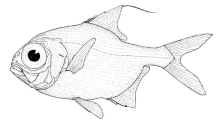Northern mucous head
| Northern mucous head | ||||||||||||
|---|---|---|---|---|---|---|---|---|---|---|---|---|

Northern mucous head ( Beryx decadactylus ) |
||||||||||||
| Systematics | ||||||||||||
|
||||||||||||
| Scientific name | ||||||||||||
| Beryx decadactylus | ||||||||||||
| Cuvier , 1829 |
The Northern Schleimkopf or Kaiserbarsch ( Beryx decadactylus ) is not a real perch, but a representative of the Berycidae , which, so to speak, were only close to the ancestral form of the Perciformes in the Cretaceous - as a berycide it belongs to the order Beryciformes , i.e. more primitive barbed fish . Like Beryx splendens , it has been increasingly “exploited” commercially since the late 1960s. The Cuviersche generic name (1829) is sometimes associated with the Italian bericerelated. But since Cuvier described the genus and species on the basis of a (dry) specimen whose proof of origin had been lost, it cannot be assumed that he simply graced a trivial name "berice" - nor that this name was already common at the time.
description
The names " Alfonsin (o), Alfonsim" were given because of their physiognomic resemblance to a Spanish ruler (chin protruding), "Schleimkopf" because of the well-developed head sideline system, which at the beginning (19th century) was only considered to be "slime-producing" . Lowe ( lc ) describes this very well: The (usually in fish bone tubes lying) "channels" are here open, jelly-filled gullies, only skin covers (like the ruffe or Sciaenidae - the feel of the fish you can feel both the hard edges the grooves as well as the soft jelly in them). Sensory mounds (neuromasters) in the jelly respond very finely to pressure waves emanating from prey and enable the fish to acquire food even in the dark (night or deep sea) - eyes very large, iris scarlet (not lighter).
Body strongly flattened laterally, shorter and more rounded in profile than in B. splendens , abdominal edge "sawn". Skin and fins scarlet red (“redfish, fish, bream”); Sides silvery (reticulated), d. H. the fish always looks black in the depths. Fins z. Sometimes lined with dark. The medium-sized scales (approx. 3 per vertebra; 24 vertebrae) always stick out a little, the fish is rough. The scale spur are not mobile (in contrast to the Perciformes - actually spinoid instead of ctenoid scales ). Lacrimale in front with thorn. Two supramaxillaria; Maxillary still involved at the edge of the mouth. Teeth as in B. splendens ; in contrast to this at the gastric outlet 70 to 100 appendices pyloricae. Up to 100 cm long, weighs 5 kg, then allegedly over 100 years old (at least slow-growing: a 52 cm long fish from the Azores is 13 years old). The largest individuals are very rare because natural mortality (from predators - e.g. Ruvettus , Thunnus , Latimeria ) is already high.
Fins formula : D IV / 18-20, A IV / 26-30, PI / 10 (Name: "ten-fingered") -11, VI / 9-13, C (18-) 19 (16 or 17 divided; with a few short ones Pre-rays stiffened).
It is a fish of medium depth, on the continental slopes and over submarine mountains, mostly between 200 and 500 m, sometimes living up to 1300 m; he prefers the proximity of detritus-rich sediments (e.g. mud). At night it rises and thereby moves away from the substrate into the open water, where it also spawns (in "winter": eggs repeatedly released in clumps; pelagic like the prickly larvae that develop near the coast). It lives socially and feeds (bathy- to mesopelagic) on crustaceans, smaller fish and cuttlefish. As an important food fish (with appropriate equipment: trawls, ground nets, longlines - caught locally, e.g. off Madeira , for 200 years), it is now threatened in some places because it only reproduces slowly (cf. also Hoplostethus atlanticus ).
Occurrence
Between 70 ° N (name!) And 50 ° S: close to the coast in all seas, except the polar ones (up to Patagonia) - also in the western Mediterranean and the Aegean (of course not in the Black Sea) and in the southern Red Sea. Rarely in the North Pacific or off Labrador. On the basis of genetic analyzes it can be assumed that the species comprises only one population because the larvae ensure slow gene exchange worldwide; regional meristic differences are therefore due to developmental physiology.
literature
- William King Gregory: Fish skulls.- 1933. http://www.archive.org/stream/fishskullsstudyo00gregrich
- Richard Thomas Lowe: A history of the fishes of Madeira.- London 1843-1860. http://www.archive.org/stream/historyoffisheso00lowe
Web links
- Northern Schleimkopf on Fishbase.org (English)
Individual evidence
- ↑ in the third volume of the "Histoire naturelle des poissons" by Cuvier and Valenciennes , p. 226.
- ^ RT Lowe (1843): The fishes of Madeira, p. 49


